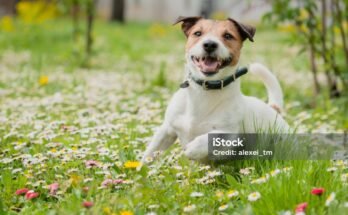Introduction:
Stress and anxiety are common in our furry friends since they live in a busy world with too many stimuli for even the most stoic of creatures to handle. Particularly sensitive animals, dogs’ emotions can be readily triggered by a variety of stimuli, such as loud noises or separation anxiety. Thankfully, improvements in pet care have sparked the creation of creative alternatives, such as the Calmer Collar. This blog post delves into the topic of dog calmness, examining the importance of Calmer Collars and their potential to enhance our pets’ quality of life.
Understanding Canine Anxiety:

Understanding the root causes and signs of anxiety in dogs is crucial before delving into the specifics of the Calmer Collar. Anxious dogs can exhibit a variety of behaviors, such as increased barking, pacing, panting, shaking, or even acting aggressively. Appropriate interventions to alleviate their suffering can be provided with the help of early recognition of these signs.
Anxiety in dogs can stem from several factors, such as:
- Fear of Being Alone: Dogs are pack animals by nature, and they develop close relationships with the members of their human families. Some dogs may get separation anxiety when they are left alone for long periods. This anxiety is caused by a dread of being left alone or abandoned, which leads to uncomfortable actions including gnawing on objects, excessive barking, urinating or defecating indoors, and trying to flee. When their owners are about to depart, dogs that suffer from separation anxiety frequently show symptoms of distress, including panting, pacing, drooling, and whimpering. When the owner is about to leave, these actions could get more intense and might not stop until the owner gets back.
- Noise Sensitivity: Due to their acute senses, dogs may become frightened or anxious when they hear loud or unexpected noises. Vacuum cleaners, loud music, fireworks, thunderstorms, and construction noise are a few common noise triggers. In response to these sounds, dogs may run, hide, shake, pant, or seek solace from their owners. Dogs who are sensitive to noise may find it more difficult since they may think that these noises are dangerous to their safety. Recurring exposure to stressful noises over time can increase anxiety and cause heightened sensitivity and terror reactions.
- Travel Anxiety: Going on a trip can be a stressful experience for certain dogs, particularly if it includes driving or visiting new locations. Anxiety related to travel can appear as agitation, whining, vomiting, drooling, or panting. Dogs may also attempt to flee or refuse to get inside the car. Motion sickness, car anxiety, unpleasant memories of previous travel experiences, and discomfort in strange places are just a few of the causes of travel anxiety. Anxiety in dogs can also be exacerbated by anticipating travel-related events, such as visiting a vet or boarding facility.
- Changes in the Environment: Because dogs are creatures of habit and familiarity, big changes in their surroundings can unsettle them and make them feel anxious. Relocating to a new residence, altering household members’ schedules, remodeling or renovating, and adding a new pet are common environmental changes that might stress out dogs. When their environment changes, dogs may react with withdrawal, hostility, house soiling, excessive barking, or destructive behavior. These are examples of indicators of anxiety in dogs. To help their dogs adjust and feel secure in their new surroundings, pet owners must offer assurance, consistency, and a set routine during times of change.
Addressing Anxiety in Dogs:
Prioritizing dogs’ emotional well-being begins with an understanding of the causes of their worry. Pet owners can assist their pets in effectively managing their anxiety by taking a few proactive steps:
- Make Sure Your Dog Gets Enough Exercise and Mental Challenges: A dog’s physical and mental well-being depends on getting regular exercise and mental stimulation. To help your dog feel less anxious and agitated, take them on walks, playtime, engaging activities, puzzle toys, and training sessions.
- Establish a Secure and Cozy Environment: Provide a cozy, secure space for your dog to go when they’re feeling nervous. To encourage relaxation, this could entail setting up a comfortable bed, pheromone diffusers, and calming music or white noise.
- Gradual Desensitization: Introduce your dog to triggering stimuli, including loud noises or car rides, gradually in a positive and regulated way. To help your dog identify the stimulus with happy events, use counterconditioning strategies like matching it with praise or treats.
- Seek Professional Advice: Consult a veterinarian or a professional animal behaviorist for advice if your dog’s anxiety is severe enough to cause substantial impairment to their quality of life. They can assist in evaluating your dog’s behavior, locating underlying causes, and creating a customized treatment plan that might involve medication, behavior modification methods, or alternative therapies.
Traditional Methods vs. Innovative Solutions:

When it comes to treating canine anxiety, pet owners have typically turned to natural therapies, behavioral training, or pharmaceuticals. Although these techniques might work well for certain dogs, they might not offer complete relief or might have unfavorable side effects.
Innovative methods of treating canine anxiety in a non-invasive way, like as pheromone diffusers, relaxing collars, and anxiety wraps, have become more and more popular in recent years. Of them, the Calmer Collar is particularly noteworthy as a potentially helpful choice for pet owners looking for a gentle, all-natural, and drug-free method of calming their furry friends down.
Presenting the Soothing Collar:
With the innovative Calmer Collar, dogs who are stressed or anxious can receive gentle pressure therapy. In contrast to conventional collars, the Calmer Collar has an innovative design that gently presses on particular acupressure points on the dog’s neck to encourage calm and security.
Key Features of the Calmer Collar:
- Pressure Therapy: The Calmer Collar calms nervous dogs by using pressure therapy techniques, which are akin to cradling newborns. Calm and well-being are encouraged by the parasympathetic nervous system, which is stimulated by the collar’s light pressure.
- Comfortable Design: The Calmer Collar’s construction is based on soft, breathable fabric for optimal comfort. With its adjustable fit, dogs of different sizes and shapes can enjoy a snug fit without experiencing discomfort or movement limitations.
- Drug-Free Alternative: The Calmer Collar provides a drug-free option for treating canine anxiety, in contrast to medications, which may have adverse effects or need a protracted adjustment time. It can be worn continuously without risk and, for best effects, along with other relaxing techniques.
- Versatility: The Calmer Collar can be used in a variety of scenarios to help calm your dog down, regardless of whether they are anxious due to separation anxiety, noise sensitivity, travel anxiety, or simply general anxiety. Use it during stressful events like thunderstorms, fireworks, veterinary appointments, and automobile rides.
- Easy to Use: Pet owners can use the Calmer Collar whenever needed because it’s easy to put on and take off. Its long-lasting effectiveness is readily maintained by giving it a machine wash.
The Science of Pressure Treatment:
Pressure therapy, sometimes referred to as deep touch pressure or proprioceptive input, has been the subject of substantial research on both humans and animals. It is predicated on the notion that uniformly applied, mild pressure can trigger the release of neurotransmitters linked to emotions of well-being and relaxation, such as dopamine and serotonin.
Pressure treatment has been demonstrated to have a relaxing impact on the nervous system in dogs, lowering cortisol levels, blood pressure, and heart rate. Pressure treatment can reduce anxiety and foster a sense of stability by gently applying pressure to particular body locations, such as the neck or torso.
Using the Calmer Collar Effectively:

To get the most out of the Calmer Collar, it’s essential to follow these tips for effective use:
- Appropriate Fit: Both the comfort and efficacy of the Calmer Collar for your dog depend on how well it fits. The collar should not be too tight or too loose; it should fit your dog’s neck snugly. Having two fingers comfortably fit between the collar and your dog’s neck is a reasonable rule of thumb. This guarantees that your dog won’t experience pain or have their movement restricted while the collar applies light pressure to the right acupressure sites.
- Gradual Introduction: It’s important to gently introduce the Calmer Collar to your dog, particularly if they’re not used to wearing collars or other accessories. Before placing the collar on, let your dog have a whiff and explore it. Once your dog is comfortable, introduce the collar gradually during quiet, soothing activities. Start by wearing it for little intervals of time, like a few minutes at a time, and progressively extend it over a few days or weeks. This method of introducing the collar gradually lessens the chance of resistance or discomfort while helping your dog link it with good things.
- Use as Needed: The Calmer Collar is made to offer your dog comforting relief in stressful circumstances or events that make them anxious. With the collar, your dog will feel safer and more peaceful during any event—a rainstorm, fireworks, vehicle journey, or vet visit. Put the collar back on your dog after the stressful incident is over. Keep it on your dog at that time. In times of necessity, you can assist your dog manage anxiety better by utilizing the collar strategically.
- Combine with Other Calming Techniques: Although the Calmer Collar by itself has its uses, it can be far more helpful when combined with other soothing techniques, particularly for dogs who experience anxiety or have triggers in their lives. In addition to the collar, you may want to employ herbal supplements, pheromone diffusers, or behavioral training methods to give your dog complete emotional support. Try out several combinations until you find the one that works best for your dog, as every dog is different.
- Keep an Eye on Behavior: To gauge the effectiveness of the Calmer Collar and make sure your dog is comfortable, keep a close eye on how your dog behaves when wearing it. Keep an eye out for indicators of relaxation, including less pacing, shaking, or panting. To determine your dog’s degree of comfort and confidence, you should also watch their general mannerisms and interactions with their surroundings. If you have any negative reactions or discomfort indicators, including scratching or trying to take off the collar, stop using the product and seek advice from your veterinarian. They can offer suggestions or modifications to make sure the collar is helping your dog and not hurting it.
By following these usage guidelines, you can maximize the benefits of the Calmer Collar and provide your dog the support they need to manage stress and anxiety effectively. Always be patient, and considerate of your dog’s demands, and adjust the collar’s usage as necessary to ensure that both you and your dog have a wonderful experience.
FAQs
The Calmer Collar: What Is It?
A specifically made dog collar called the Calmer Collar uses light pressure treatment to reduce stress and anxiety in canines. It improves relaxation and a feeling of security by applying light, steady pressure to particular acupressure sites on the neck.
The Calmer Collar: How Does It Operate?
The Calmer Collar operates on the same pressure treatment premise as swaddling a baby. Inducing relaxation and lowering stress levels is the parasympathetic nervous system, which is aided in activation by the collar’s mild pressure. This helps dogs feel more at ease and content.
What advantages does wearing a Calmer Collar offer?
Several advantages of the Calmer Collar include:
- offers stress and anxiety relief without the use of drugs
- aids in calming dogs in tense circumstances like thunderstorms, fireworks, and vehicle rides
- encourages relaxation and lessens anxiety-related negative behaviors, like excessive barking or destructive chewing
- For optimal effect, it can be used with other relaxing techniques.
Does my dog need the Calmer Collar?
Following instructions, the Calmer Collar is safe for use on dogs. Designed to be comfortable for longer wear, it is made of soft, breathable fabric. It’s crucial to check that your dog wears the collar correctly, though, and to keep an eye on their behavior to make sure they’re not uncomfortable.
What size is appropriate for my dog’s Calmer Collar?
Please measure your dog’s neck circumference and use the manufacturer’s sizing chart to help you choose the appropriate size. It should be just right—not too tight or too loose—to fit your dog’s neck snuggly. To guarantee maximum effectiveness, it’s critical to adhere to the manufacturer’s size instructions.
Can I wear the Calmer Collar all the time?
While wearing the Calmer Collar continuously is safe, it’s usually advised to use it when your dog exhibits signs of stress or other circumstances that make them anxious. Long-term usage of the collar may also cause some dogs to grow acclimated to its pressure, decreasing its effectiveness. You must constantly watch your dog’s behavior and modify how the collar is used as necessary.
How is the Calmer Collar to be cleaned?
The Calmer Collar is simple to maintain because it is machine washable. All you need to do is take off any inserts or attachments, protect the collar with a mesh laundry bag or pillowcase, and then wash it on a soft cycle using a light detergent. Let the collar completely air dry before reattaching any parts and returning it to your dog.
Are puppies safe to use with the Calmer Collar?
Puppies can wear the Calmer Collar; however, it is imperative that they be closely watched while it is on and that the collar be properly suited for their neck circumference. Puppies may require some time to become used to wearing the collar, so it’s best to introduce it gradually and pay close attention to their behavior to make sure they’re comfortable.
What other anxiety drugs or treatments can the Calmer Collar replace?
A dog’s anxiety can be effectively controlled with a calmer collar, but severe or long-term anxiety disorders may not respond well to this kind of treatment. For the best course of action for your dog’s needs, you must speak with your veterinarian. This could incorporate a mix of medication, supportive therapy, and behavioral change strategies.
Where may the Calmer Collar be bought?
The Calmer Collar can be bought online at the manufacturer’s website as well as from several pet supply merchants. Make sure you purchase from reliable sources and confirm the product’s authenticity to guarantee you get a real Calmer Collar that is covered by the warranty and assistance of the manufacturer.



